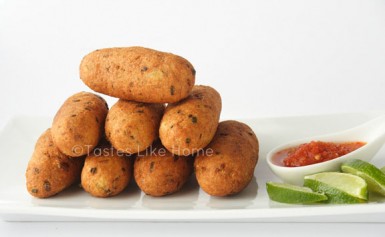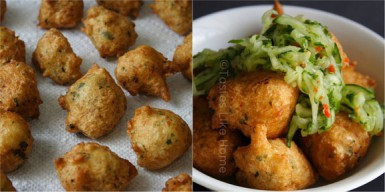Hi Everyone, Serve a Guyanese a fish cake that doesn’t look like the fish cakes they are accustomed to and they fight hard to hide their shock as they reluctantly reach for it. If they take a bite and there’s no evidence of an ample amount of fish in the fish cake, then throw out everything you ever thought of Guyanese – polite, humble, generous, and mannerly, for they suddenly become arrogant, overbearing and boastful. You would swear that only in Guyana proper fish cakes are made or that only Guyanese know how what fish cakes are. I know you think I am exaggerating but if you’ve ever lived outside of Guyana, you would know that what I am saying is true.
I had my own personal moment of bewilderment a year after arriving in Barbados, ordering fish cakes at a gathering and being disappointed when I saw what I’ve now come to know and love as Bajan fish cakes. At the time I had complained to my Bajan companion and proceeded to explain my expectations of a fish cake. I think the complaint fell on deaf ears. And there could have been some rolling of the eyes on the part of my companion.
 While in conversation with a couple of Guyanese this past week (on separate occasions), I was reminded of how fussy we get about our fish cakes. Essentially, the complaints were two fold. One, that there was not enough fish in the fish cakes. And two, fish cakes are made with fresh fish that is steamed or boiled but not salt fish. If one uses salt fish, then it is salt fish cakes and not fish cakes! Oy! The hairline arguments! A Guyanese friend living in the United States recently posted a recipe and photographs of fish cakes she had made – wonderful, round, plump fish cakes. The fish cakes were praised, however, someone did comment about the shape of the fish cakes, pointing out that the fish cakes her mother-in-law makes are rolled lengthways into thick short logs, instead of being shaped round. I couldn’t help but smile.
While in conversation with a couple of Guyanese this past week (on separate occasions), I was reminded of how fussy we get about our fish cakes. Essentially, the complaints were two fold. One, that there was not enough fish in the fish cakes. And two, fish cakes are made with fresh fish that is steamed or boiled but not salt fish. If one uses salt fish, then it is salt fish cakes and not fish cakes! Oy! The hairline arguments! A Guyanese friend living in the United States recently posted a recipe and photographs of fish cakes she had made – wonderful, round, plump fish cakes. The fish cakes were praised, however, someone did comment about the shape of the fish cakes, pointing out that the fish cakes her mother-in-law makes are rolled lengthways into thick short logs, instead of being shaped round. I couldn’t help but smile.
Our fish cakes – from whence they came

The distinct log or quenelle-shaped fish cake to which we are accustomed to draws its influence from Portugal. Pastéis de bacalhau, codfish pasties or codfish cakes, made simply of salted codfish, mashed potatoes, eggs and parsley are mixed together, deep fried and served as an appetizer, side dish or as a meal itself.
In Portugal it is traditionally made with salted cod but as with many foods that have travelled, I imagine that given the plethora and variety of fish that we get in Guyana, it seemed a no-brainer to make fish cakes using fresh fish. I think a more telling reason for using the fresh fish though might have something to do with the cost of salt fish. Access to fresh fish would have been much easier and readily available too.
Another adaption to this Portuguese favourite has to do with the seasoning. Our fish cakes have in a lot more aromatics and herbs to really spice up the mixture, and this may been as a result of using the fresh fish instead of salt cod. Reason being that salt fish has its own savoury and unique flavour that it brings to any dish in which it is included.
It is clear, however, that we have stuck to the principles of making the dish – we mix the fish with potatoes (or adapted with various ground provisions), bind it with eggs, form the signature shape and deep fry it the same way.
We are not alone…
In Brazil, a similar type of fish cake is made. It is called Bolinhos de bacalhau. In the French Antilles they call it Accras de morue. Many other countries and regions that use a lot of salt fish in their cuisine also have a version of salt cod fish cakes.
As a matter of fact throughout the world you can find fish cakes in some form or fashion, and a lot of them are not necessarily made with salted or fresh fish. Some are made with canned fish such as sardines, mackerel, tuna, or salmon.
The other type of fish cakes

Barbados, Trinidad & Tobago, Jamaica and other countries throughout the Caribbean and elsewhere make another type of fish cakes that though very different from the Guyanese version of fish cakes are equally famous, favoured and fawned over. These types of fish cakes are more fritter-like in appearance. They are always made with salt fish that is pounded or shredded very finely, mixed with hot peppers, garlic, thyme and onions (some versions add in more herbs) along with flour and a bit of baking powder, and with just enough water to make a batter and then fried. Jamaican salt fish cakes are flatter because they are shallow fried and are called stamp and go. In Barbados they are deep fried and known as fish cakes and elsewhere they are known as accras, or salt fish accras or salt fish fritters.
As I said a couple of weeks ago, let’s not limit ourselves in terms of the kind of food experiences we can have. So, it is not the fish cakes to which you are accustomed; does it hurt to try and appreciate another version?
Cynthia
[email protected]
www.tasteslikehome.org








